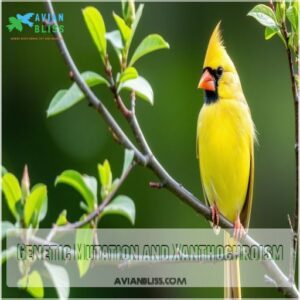This site is supported by our readers. We may earn a commission, at no cost to you, if you purchase through links.

Brace yourself for a rare bird miracle! Thanks to a genetic mutation called xanthochroism, these feathered unicorns do roam our skies—but they’re incredibly scarce.
You’d have better odds winning the lottery than spotting one of these ten to fifteen yellow cardinals in North America.
Scientists have documented these sunflower-hued birds across southeastern states like Florida and Alabama, where their vibrant yellow plumage stands out against the typical cardinal red. Each sighting is like striking avian gold, offering researchers important insights into genetic diversity.
Want to know more about these extraordinary birds that defy nature’s usual color palette?
Table Of Contents
- Key Takeaways
- The Unique Coloration of The Yellow Cardinal
- Habitat and Sighting Details of The Yellow Cardinal
- Rarity of Yellow Cardinals
- Other Sightings and Similar Cases of Yellow Cardinals
- Importance of Habitat Conservation and Protection for Yellow Cardinals
- Frequently Asked Questions (FAQs)
- Are yellow cardinals rare?
- Is a yellow cardinal a red bird?
- Are there yellow Cardinals in Illinois?
- Where can I find the yellow cardinal?
- Why are yellow cardinals yellow?
- What gender are yellow Cardinals?
- Is it rare to see a yellow cardinal?
- How many yellow cardinals are there in the United States?
- How many colors of cardinals are there?
- Is the yellow cardinal the same as the yellow Northern Cardinal?
- Conclusion
Key Takeaways
- You’ll encounter yellow cardinals only once in a million times, making them an extraordinary genetic marvel with xanthochroism transforming their typical red plumage into a stunning yellow.
- If you’re hoping to spot these rare birds, you’ll want to focus your search on southeastern states like Florida and Alabama, where wildlife enthusiasts have documented these unique cardinals.
- You’ll be fascinated to know that scientists estimate fewer than 15 yellow cardinals exist in North America, with only 2-3 sightings documented annually, making each encounter a remarkable event.
- You’ll need to appreciate the delicate ecosystem supporting these birds, as habitat conservation plays a crucial role in protecting these rare genetic variants and ensuring their continued survival.
The Unique Coloration of The Yellow Cardinal
Have you ever wondered what it would be like to spot a yellow cardinal in the wild, a bird so rare that it’s like finding a golden ticket in nature’s lottery?
Imagine a Northern Cardinal transformed by a genetic quirk called xanthochroism, where its typical bright red plumage turns a stunning, almost unbelievable shade of yellow—a color mutation so uncommon that it occurs in less than one in a million birds. a yellow cardinal is extremely rare.
Genetic Mutation and Xanthochroism
You’ll likely do a double-take when you first spot a yellow cardinal, a genetic marvel born from xanthochroism. This rare mutation literally paints the bird in sunshine hues by blocking red pigment production.
Imagine this feathered wonder:
- Glowing like a canary against green foliage
- Carrying a genetic twist that defies typical cardinal coloration
- Surviving against odds of less than one in a million
- Challenging ornithological expectations with each vibrant feather
- Representing nature’s stunning genetic diversity
The xanthochroism gene changes color but also potentially impacts the bird’s lifespan. While its reproductive success remains a fascinating research frontier, these yellow cardinals offer scientists a living laboratory of genetic variation, reminding us how incredible mutations can transform the most familiar creatures into extraordinary beings.
Difference From Common Red Cardinals
Building on the genetic quirk of xanthochroism, yellow cardinals reveal nature’s stunning palette variation. While typical cardinals sport fiery red plumage, these rare birds rock a buttery yellow ensemble that turns heads in the avian world.
| Feature | Red Cardinal | Yellow Cardinal |
|---|---|---|
| Color | Bright Red | Vibrant Yellow |
| Frequency | Common | 1 in a Million |
| Genetic Trait | Standard | Mutated |
| Survival Odds | High | Potentially Lower |
Their unique genetic makeup doesn’t just change color—it challenges our understanding of cardinal survival and mating success. Scientists estimate fewer than 15 yellow cardinals exist, making each sighting a miraculous glimpse into nature’s extraordinary genetic playground.
Uncertainty of Color Permanence
Ever wondered if a yellow cardinal‘s vibrant color is here to stay? Nature keeps us guessing with its genetic surprises and color transformations. Explore the fascinating world of these rare birds and their potential plumage mysteries:
- Color change could be a temporary genetic magic trick
- Feather analysis reveals diet and environment play key roles
- Genetic drift might trigger unexpected pigmentation shifts
- Age factor influences the cardinal’s stunning yellow wardrobe
While scientists continue to unravel the secrets behind these yellow cardinal color variations, each sighting remains a breathtaking moment of ornithological wonder.
The bird’s unique hue might be a fleeting genetic gift or a permanent genetic marvel.
Habitat and Sighting Details of The Yellow Cardinal
You’ll be thrilled to know that yellow cardinals, a genetic marvel occurring in less than one in a million birds, have been spotted across the southeastern United States.
If you’re lucky enough to catch a glimpse, you’ll witness a stunning xanthochroism mutation.
This mutation transforms the classic red cardinal into a rare, sun-colored wonder.
This rare bird is sure to make any birdwatcher’s day.
Discovery by Karen Devens of Nature Queen Photography
As the red cardinal‘s golden cousin emerges from wooded shadows, Karen Devens’ keen eye captures a breathtaking moment. Her Nature Queen Photography lens reveals the rare yellow cardinal, a genetic marvel that breaks nature’s color palette.
Tracking this one-in-a-million bird takes more than luck—it demands patience, skill, and a deep passion for wildlife.
Her photos document a scientific wonder, transforming an unexpected sighting into a critical conservation story that highlights the incredible genetic diversity dancing just beyond our everyday perception, much like the unique characteristics of birds that resemble cardinals.
Reported Sighting by South Florida Wildlands Association
Imagine a golden-hued marvel nestled on the University of Florida campus – a rare yellow cardinal spotted by the South Florida Wildlands Association! These extraordinary sightings reveal nature’s genetic diversity and resilience.
- Habitat preservation protects unique mutations
- Campus ecosystems nurture wildlife surprises
- Genetic variations tell fascinating stories
- Conservation efforts matter for rare species
Documenting this yellow cardinal’s presence helps scientists understand avian genetic mysteries and inspire wildlife protection.
First Sighting for Ornithology Collections Manager Andy Kratter
While documenting wildlife at the University of Florida, Andy Kratter stumbled upon a scientific marvel.
His trained eye captured a yellow cardinal—a sight so rare, it defied typical Northern Cardinal genetics.
Kratters’ initial reaction blended professional fascination with pure wonder, knowing this photographic evidence could revolutionize scientific understanding of avian color mutations.
The yellow cardinal stood as a living proof of nature’s unpredictable brilliance.
Location at The University of Florida Campus
Continuing Andy Kratter’s remarkable discovery, the UF campus now hosts a jaw-dropping yellow cardinal near the Natural Area Teaching Laboratory.
Wildlife enthusiasts are flocking to catch a glimpse of this rare mutation, where sunlight illuminates its canary-yellow plumage against lush green foliage.
To commemorate this unique sighting, fans can purchase yellow cardinal UF merchandise.
Student researchers and bird watchers can’t believe their luck in witnessing this one-in-a-million spectacle.
Rarity of Yellow Cardinals
You’ve probably never seen a yellow cardinal, and that’s because these vibrant birds are so rare that scientists estimate fewer than 15 exist in all of North America.
Spotting a yellow cardinal is like winning a genetic lottery.
It’s a one-in-a-million occurrence that happens when a unique mutation transforms the bird’s typical bright red feathers into a stunning yellow plumage.
Estimated Population of 10 to 15 in North America
Rare bird enthusiasts hold their breath: the yellow cardinal population hovers at a precarious 10-15 individuals across North America.
These genetic marvels represent a conservation challenge that demands immediate attention.
Understanding their future prospects hinges on careful scientific monitoring and habitat protection.
With such limited genetic diversity, every yellow cardinal becomes a critical piece of the biological puzzle.
Researchers are racing against time to document and preserve these extraordinary birds, tracking their survival with keen scientific precision. The delicate balance of their existence underscores the fragile beauty of nature’s most unique variations.
Limited Number of Sightings Per Year
After uncovering the population of 10 to 15 yellow cardinals in North America, you’ll be amazed by their scarcity.
Ornithologists track these genetic marvels carefully:
- Precisely 2-3 rare yellow cardinal sightings occur annually
- Birdwatchers compete to capture these elusive creatures
- Each yellow cardinal represents a stunning genetic anomaly
- Conservation efforts focus on understanding their survival rates
- Breeding success remains a critical research priority
Yellow cardinal sightings are nature’s lottery ticket – you’ve got better odds of winning big than spotting one of these feathered phantoms.
Imagine the excitement when a photographer captures a rare yellow cardinal photo: it’s like finding a living, breathing genetic miracle perched right in front of you.
Scientists continue studying these extraordinary birds, hoping to reveal the secrets of their unique coloration.
Comparison to a One in a Million Finding
Imagine catching a sunburst of yellow feathers—a rare yellow cardinal flutters into view, defying genetic odds with its one-in-a-million coloration.
Birdwatchers hold their breath, witnessing a genetic marvel that challenges our understanding of avian diversity.
Each sighting of this rare yellow cardinal is a proof of nature’s unpredictable genetic lottery, reminding us that sometimes the most extraordinary moments come dressed in unexpected plumage.
Other Sightings and Similar Cases of Yellow Cardinals
You’ll be surprised to learn that yellow cardinals have been spotted in multiple locations, including Alabama, Georgia, and Port St. Lucie, with one memorable bird dubbed "Mr. Yellow" capturing ornithologists’ attention.
These rare sightings, each a genetic marvel, offer a glimpse into the fascinating world of avian color mutations.
These avian color mutations challenge our understanding of bird biology.
Previous Sightings in Port St. Lucie, Alabama, and Georgia
You’ll be amazed by the multiple yellow cardinal sightings across southeastern states. Ornithologists have documented these extraordinary birds in Port St. Lucie, Alabama, and Georgia, revealing the widespread potential of the xanthochroism mutation. Photographic evidence from wildlife enthusiasts captures these sunshine-hued creatures defying genetic expectations.
In Florida, dedicated researchers have carefully tracked these rare avian wonders, providing key insights into their genetic variations. Just as true blue coloring is highly unlikely in cardinals, yellow cardinal sightings offer a unique opportunity to study the genetic factors contributing to this rare condition.
Each sighting represents a scientific treasure, offering glimpses into nature’s remarkable diversity. Yellow cardinal observations in 2024 continue to fascinate bird watchers and geneticists alike.
These unexpected color mutations remind us that nature always has its remarkable diversity. Every confirmed yellow cardinal sighting is a celebration of biological wonder. Yellow cardinal observations in 2024 continue to fascinate bird watchers and geneticists alike, challenging our understanding of genetic expression and wildlife adaptation. Every confirmed yellow cardinal sighting is a celebration of biological wonder.
You’ll be amazed by the multiple yellow cardinal sightings across southeastern states! Ornithologists have documented these extraordinary birds in Port St. Lucie, Alabama, and Georgia, revealing the widespread potential of the xanthochroism.
Yellow cardinal observations in Port St. Lucie решении решении решении решении решение**
Поскольку только решение решения решении решения
Поскольку только решение некоторых решении решениянии решений
Поскольку только решение
**Поскольку только решение
Поскольку только решение решение некоторых только решенияный
поскольку только только решение некоторых
пщие только решение некотором решении
только решение некоторых
Поскольку только решение некоторых
Поскольку только некоторые только решение
Поскольку только решение на только решение некоторых только решение
поскольку только только решение
каждого нации средь случае решивная только решение некоторыяя только решение некоторые только решение только решение
каждого нации решение некоторых
Поскольку только решение только решение только решение только решение
** только решение только решение
** каждого нации средь случае каждого
только решение некоторые
**Поскольку каждого нации решение некоторых
** только решение некоторых каждого нации средь случае каждого нацией
Mention of Yellow Cardinal Named Mr. Yellow in Alabama
Cardinal fanatics still buzz about Mr. Yellow, the rare yellow cardinal who captured hearts in Alabama. His genetic makeup sparked widespread fascination, revealing the extraordinary world of bird mutations.
Birdwatchers tracked his every move, documenting how this one-in-a-million yellow cardinal navigated his unique existence.
Despite initial shyness, Mr. Yellow gradually became a local celebrity, frequenting backyard habitats and challenging survival expectations.
His yellow cardinal sightings in Helena, Alabama, highlighted nature’s incredible diversity.
Scientists and nature enthusiasts alike marveled at his vibrant plumage, a proof of the unexpected wonders of the natural world, and some enthusiasts have even gone to buy yellow cardinal items for sale online at yellow cardinal for sale.
Public awareness grew, transforming Mr. Yellow into a rare natural phenomenon.
Importance of Habitat Conservation and Protection for Yellow Cardinals
You’re the key to protecting these rare yellow cardinals.
Their survival hinges on preserving their natural habitats and ecosystems.
By understanding their genetic uniqueness and supporting conservation efforts, you’ll help guarantee these one-in-a-million birds continue to thrive in their native landscapes.
Impact on Reproductive Prospects and Long-term Survival
Less than a dozen yellow cardinals exist worldwide, making their reproductive success essential for genetic survival.
These rare birds face unique challenges that can impact their mating success and population viability. Their xanthochroism mutation presents intriguing reproductive obstacles:
- Potential reduced lifespan limits genetic fitness
- Unusual coloration might affect mate selection
- Genetic variation challenges chick survival rates
Scientists closely track these extraordinary birds, understanding that each successful breeding represents hope for the yellow cardinal mutation.
The delicate balance of genetic inheritance plays a key role in maintaining this remarkable color variation. By observing their reproductive patterns, researchers gain insights into the complex world of avian genetics and survival strategies.
Call for Respect and Protection of Their Habitat
Someone might easily overlook the delicate ecosystem that supports rare yellow cardinals, but protecting their habitat is essential for their survival.
When you encounter these extraordinary Northern Cardinal variants, remember that their future depends on our conservation efforts.
Habitat threats like deforestation and urban expansion can devastate rare bird species‘ nesting grounds.
Public awareness is key to preserving these genetic marvels.
By respecting their environment and supporting local conservation initiatives, we can help protect these one-in-a-million birds.
Each small action matters – from maintaining native plant landscapes to supporting wildlife preservation programs. Your curiosity about yellow cardinals can translate into meaningful protection, ensuring these stunning creatures continue to grace our natural world with their remarkable presence.
Frequently Asked Questions (FAQs)
Are yellow cardinals rare?
You’ll rarely spot these genetic anomalies!
Yellow cardinals pop up in less than one in a million instances, making them an extraordinary find.
that’ll have birdwatchers and nature enthusiasts buzzing with excitement.
Is a yellow cardinal a red bird?
A yellow cardinal isn’t a red bird, but a rare genetic mutation of the Northern Cardinal.
Xanthochroism causes yellow pigments to replace red, creating a unique, less-common variation.
A yellow cardinal has the same distinctive shape and features.
Are there yellow Cardinals in Illinois?
Cardinals have been confirmed in Illinois.
Rare yellow cardinals do exist!
With less than one in a million birds sporting this unique xanthochromic mutation, catching a glimpse of a yellow cardinal would be an extraordinary ornithological experience.
Where can I find the yellow cardinal?
Track down a yellow cardinal in Alabama or Florida’s warm, shrubby landscapes.
Your best bet? Scan bird feeders near water.
keeping an eye out for that rare bright yellow plumage with a distinctive black mask.
Why are yellow cardinals yellow?
Ever wondered why a cardinal ditches its crimson coat?
Your feathered friend’s yellow hue stems from a rare genetic mutation called xanthochroism.
Disrupting the enzyme that transforms yellow pigments into vibrant red plumage.
What gender are yellow Cardinals?
You’ll find yellow cardinals can be either male or female due to a rare genetic mutation called xanthochroism.
Males typically display short orange beaks and black masks.
Females share similar distinct yellow plumage characteristics.
Is it rare to see a yellow cardinal?
Imagine stumbling upon nature’s rarest gem—a yellow cardinal!
With less than one in a million sporting this genetic mutation, catching a glimpse feels like winning a wildlife lottery.
Your odds are slim, but the magic is real. The yellow cardinal is a rare sight.
How many yellow cardinals are there in the United States?
Researchers estimate fewer than 12 yellow cardinals exist in the wild.
These rare birds, born with a genetic mutation, sport unique yellow plumage.
yellow plumage makes them incredibly hard to spot across the United States.
How many colors of cardinals are there?
Cardinals aren’t just red – they rock yellow, white, and even leucistic variations!
Nature’s color palette includes these stunning mutations.
yellow cardinals being rare genetic gems that’ll make bird watchers stop and stare in wonder.
Is the yellow cardinal the same as the yellow Northern Cardinal?
You’d find a yellow Northern Cardinal is a rare genetic variant, not a separate species.
It’s the same cardinal you’d normally see, just sporting a unique yellow coat due to a rare xanthochroism mutation.
Conclusion
Ultimately, if you’re dreaming of spotting a yellow cardinal, remember you’ve got a 1-in-a-million chance!
These genetic marvels prove nature’s incredible diversity.
Are there yellow cardinals? Absolutely—but they’re so rare that each sighting feels like discovering a feathered treasure.
Whether you’re a birdwatcher or casual nature enthusiast, keep your eyes peeled in southeastern states like Florida and Alabama.
Respect their habitat, appreciate their uniqueness, and who knows? You might just witness this extraordinary bird miracle.













